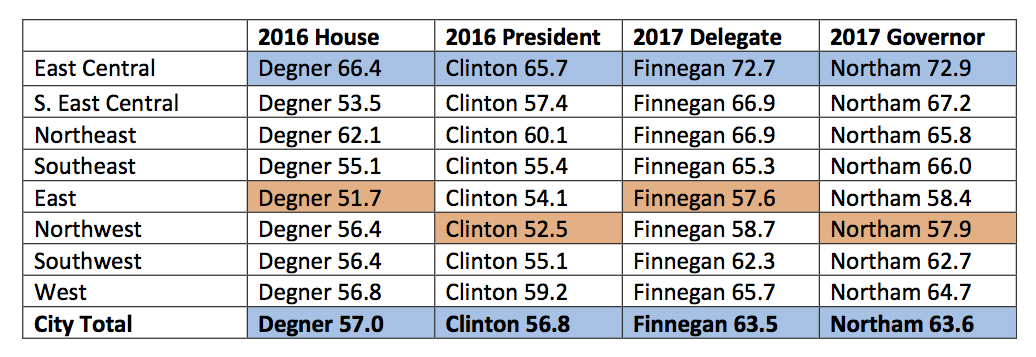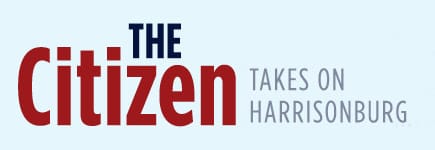By Andrew Jenner
This post was updated on 10/30 to replace an erroneously inserted chart with the correct one comparing two precinct-level vote totals to citywide results since 2016.
Next Tuesday’s election will be the first mid-term in which JMU students will have their own precinct, which was created to help boost student turnout. If that ends up happening, how might it affect the city council races?
If recent history’s any guide, a big student turnout may not give Democrats much of a boost, no matter what conventional wisdom says about how students vote.
First, turnout among JMU students has been extremely low in non-presidential elections. According to Tufts University’s National Study of Learning, Voting and Engagement, just 8.8 percent of JMU students voted in the 2014 midterms. That was less than half the national average of 18.1 percent turnout among college students. This time around, the James Madison Center for Civic Engagement – which recently partnered with The Citizen to publish a local voting guide – is working to improve that through its Dukes Vote program, which has led registration drives, held an on-campus candidate town hall tour and is sponsoring a “Walk Together to the Polls” effort to increase turnout.
Whether students vote is one thing. But it’s how they vote – especially if turnout increases – that has a bearing on local elections. Most people suppose that student voters lean left. That assumption sometimes figures into explanations about Harrisonburg’s emergence as a reliably blue city over the past 15 years. And during the 2008 election, some city Republicans on election night blamed that year’s Democratic sweep of three council seats on the student vote. A closer look at returns, however, suggests that JMU students – or at least those who live and vote on campus – aren’t even close to the city’s most progressive voters.
Until 2016, the JMU campus was part of the city’s East Central precinct. Also encompassing Old Town, it’s been one of the most liberal parts of the city in recent years. The chart below shows precinct-level results for five major races between 2012 and 2015, all of them won citywide by Democrats. (The only Democrat below not elected to office was April Moore, who lost the 2015 state Senate race to Sen. Mark Obenshain (R).) In three of those races, the East Central precinct saw the highest Democratic vote totals; in the 2012 races, it was second.

This and all subsequent charts show the winning candidate and the percentage of the vote that candidate captured in each precinct. The most Democratic-leaning one in each election is highlighted in blue; the most Republican-leaning (in some cases, that’s simply the one with smallest Democratic margin of victory) is in red. All data in this and subsequent charts from the Virginia Department of Elections.
Next, here’s a comparison of the East Central precinct to citywide results, showing that it voted more Democratic than the rest of Harrisonburg – sometimes by more than 8 percentage points.

Things become a little more illuminating in 2016, when the city cleaved JMU from the East Central precinct to create a new, campus-only precinct called the South East Central. In the four state and national races since, the remainder of the East Central precinct – now limited to Old Town and neighborhoods along Reservoir Street – has become even more Democratic. Meanwhile, the new, standalone JMU precinct is considerably less so.

Precincts with the highest and lowest Democratic margins of victory are highlighted in blue and red, respectively.
Here’s a closer look at how the East Central and South East Central compare to city totals, showing that JMU students who live and vote on campus are certainly not the most left-leaning voters in the city.
 Finally, check out this set of charts looking at the JMU student effect on the 2016 city elections (again, we’re talking on-campus students when it comes to the South East Central precinct; major off-campus housing complexes are primarily divided between the East and Southeast precincts). That year, three Democrats and one independent, George Hirschmann, ran for three seats on council. Below are how the candidates ranked, from first to fourth, in each of the precincts, along with the overall results. The East Central precinct, sans on-campus students, was the Democrats’ strongest. Meanwhile, the South East Central, aka JMU, gave Hirschmann his best result on the way to finishing second – good enough for the council seat he now occupies.
Finally, check out this set of charts looking at the JMU student effect on the 2016 city elections (again, we’re talking on-campus students when it comes to the South East Central precinct; major off-campus housing complexes are primarily divided between the East and Southeast precincts). That year, three Democrats and one independent, George Hirschmann, ran for three seats on council. Below are how the candidates ranked, from first to fourth, in each of the precincts, along with the overall results. The East Central precinct, sans on-campus students, was the Democrats’ strongest. Meanwhile, the South East Central, aka JMU, gave Hirschmann his best result on the way to finishing second – good enough for the council seat he now occupies.

In 2016, three Democrats (blue) and an Independent (yellow), ran for three city council seats. The top three vote-getters citywide – Reed, Hirschmann and Baugh – were elected, though their performances varied considerably by precinct. Democrats’ worst result was at JMU’s South East Central precinct.














